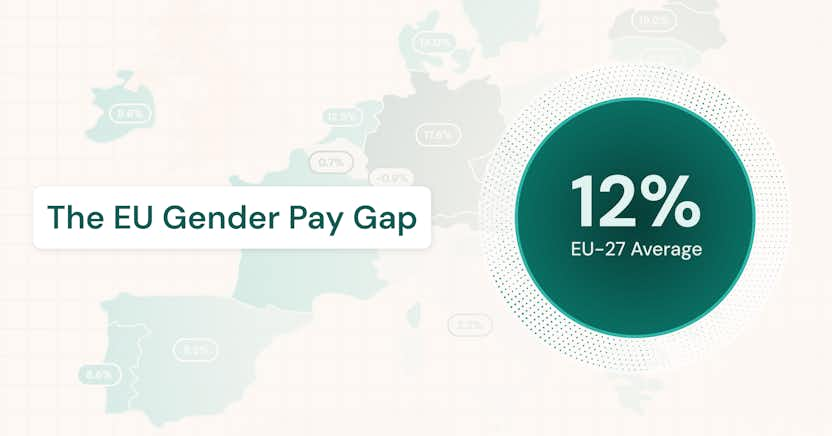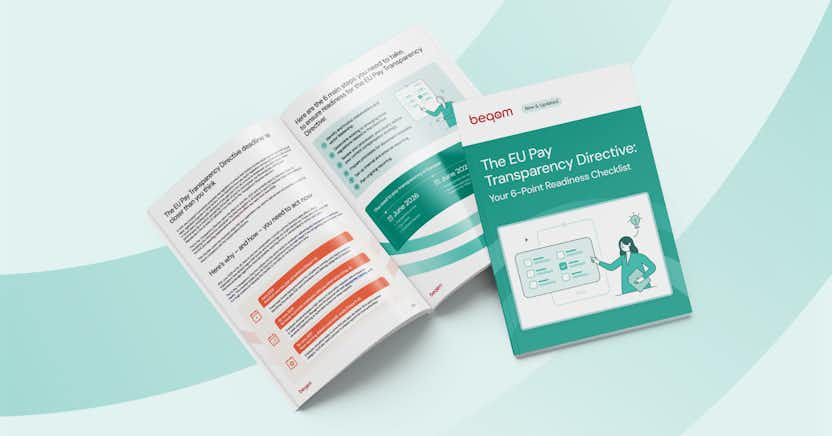
Learn more about the following beqom products
Updated based on the European Commission amendments to the CSRD compliance dates, approved 3 April 2025.
Starting in January 2023, the European Union implemented the Corporate Sustainability Reporting Directive (CSRD). This new legislation, rooted in the EU Green Deal, aims to update the requirements for corporate transparency on both social and environmental sustainability practices.
The CSRD's purpose is to provide more transparent data for investors and other stakeholders, and to encourage companies to develop more responsible business approaches.
The CSRD emphasizes the need for companies to disclose more comprehensive and standardized information, including metrics related to social issues like pay equity. For large EU Public Interest companies, the first required reports are due in 2025, based on 2024 data. For other companies, the initial dates have been delayed from their original targets, as described below.
Why is CSRD compliance important?
There are many good reasons to comply with the Corporate Sustainability Reporting Directive (CSRD), and risks to not complying, including:
Legal implications: Generating comprehensive reports to demonstrate compliance can strengthen legal positioning, and help avoid costly legal battles, litigation risks, and potential settlements.
Regulatory goodwill: Regulators expect compliance and transparency; non-compliance may lead to regulatory investigations and stringent audits.
Business continuity: In cases of non-compliance, regulatory bodies may impose corrective measures, which could lead to operational disruptions.
Reputation: Compliance helps maintain a reputation of integrity. Non-compliance can damage a company's reputation, erode consumer trust, and deter corporate partnerships.
Employer brand: In line with reputation, as companies compete for talent, pay equity and transparency practices can be an important competitive differentiator.
Investor confidence: Investors and stakeholders may view companies who are in compliance more favorably, and conversely place increased scrutiny on companies that fail to comply, potentially leading to divestment.
Penalties: Penalties for non-compliance vary across the EU, but are likely to include enforcement actions and fines in many countries. For example, France has introduced personal liability, with fines and jail time for company directors.
Ease of financing: Lenders like companies that are transparent and compliant; those that do not meet the CSRD's requirements may face difficulties in obtaining loans and other forms of financing.
Understanding the EU's Corporate Sustainability Reporting Directive (CSRD)
The CSRD supersedes the Non-Financial Reporting Directive (NFRD), which has been in force since 2014 and only applied to public-interest entities with over 500 employees. In contrast, the CSRD has a broader scope, incorporating a comprehensive approach to sustainability that includes both environmental and social dimensions. It promotes an economic framework that ensures fairness in resource usage and supports human and worker well-being.
Under the CSRD, companies must provide detailed disclosures on environmental and governance matters, such as greenhouse gas emissions, resource consumption, pollution levels, and corporate governance practices. Additionally, they must report on social and human rights factors, covering topics like fair labor practices, equitable wages, and diversity in the workforce.
Who must comply with the CSRD?
The CSRD applies to all large companies in the EU, defined as those with over 250 employees, a net turnover of over €40 million, or more than €20 million in total assets. It also includes all companies listed on EU-regulated markets (except for micro-enterprises) and certain non-EU companies with significant operations in the EU, such as subsidiaries or branches. Additionally, the directive covers small and medium-sized enterprises (SMEs) listed on EU markets, certain banks, and insurance companies. These entities are required to comply with new sustainability reporting standards and provide more detailed information on environmental, social, and governance (ESG) factors.
What are the reporting standards for the CSRD?
The CSRD's reporting standards are outlined in the European Sustainability Reporting Standards (ESRS), which were first published in 2023. The ESRS is a reporting standard that will be used to meet the requirements of the CSRD. The broad requirements include:
Disclosure of information
Companies must disclose information on a wide range of sustainability topics, including environmental, social, and governance topics. This includes how a company's activities impact the planet and people, how sustainability goals impact the company's financial health, and more. (More details on the specific information later.)
Double materiality
Companies must disclose both the risks they face from climate change and the impacts they may cause to the climate and society.
Mandatory assurance
All reported sustainability information must be accompanied by a mandatory assurance obligation.
Value chain disclosures
All relevant disclosures must extend to the company's value chain, including products and services, business relationships, and supply chain.
The role of the CSRD in promoting gender equality and pay equity
The CSRD considers gender equality and pay equity to be social issues, and addresses them by requiring companies to disclose pay gap information and other data as part of their sustainability efforts. This includes transparency in areas like equal pay for equal work and gender diversity within organizations. By mandating disclosures on gender pay gaps and equal opportunities for all, the CSRD pushes businesses to actively address disparities, ensuring that compensation structures are fair and inclusive. Additionally, the directive encourages organizations to implement policies that promote gender diversity at leadership levels and foster an equitable workplace.
This increased focus on reporting and transparency creates a stronger incentive for companies to take action in achieving gender equality and eliminating pay inequities, thereby supporting broader sustainability and social justice goals within the EU.
Defining “employee category” in the context of reporting
The term “employee category” refers to classifications of employees based on their job role, level within the organization, or type of employment contract (such as full-time or part-time). When reporting on gender pay gaps, employers might segment data by various employee categories, including but not limited to:
- Administrative or support roles
- Professional or technical staff
- Different management levels
- Permanent, contracted, or temporary employees
- Executive positions
- Full-time versus part-time employment
Timeline for reporting under the CSRD
Initially, large enterprises had to begin compliance with the new requirements starting in 2024, with initial reports due in early 2025, and SMEs listed on EU markets were to begin their reporting in 2026. However, on 3 April 2025 the European Parliament approved a proposal to delay the application of sustainability reporting requirements by two years for some companies.
The original deadline of 2025 still applies for Large Public-Interest Entities (PIEs) with >500 employees. However, the 2nd and 3rd wave companies received a 2-year postponement on reporting requirements, so other large companies (non PIE, >250 employees) will report in 2028 (for FY 2027) and SMEs will report in 2029 (vs. for FY 2028).
The changes are summarized in the following table:
Entity Type | Original Compliance Start | Amended Compliance Start | First Report Due | Notes |
|---|---|---|---|---|
Large Public-Interest Entities (PIEs) with >500 employees | January 21, 2024 | Unchanged | 2025 (covering FY 2024) | Entities already subject to the Non-Financial Reporting Directive (NFRD). |
Other Large Companies (Meeting at least two of the following: >250 employees, >€50 million net turnover, >€25 million total assets) | January 1, 2025 | January 1, 2027 | 2028 (covering FY 2027) | Compliance delayed by two years. |
Listed Small and Medium-Sized Enterprises (SMEs) | January 1, 2026 | January 1, 2028 | 2029 (covering FY 2028) | Listed SMEs can opt out for an additional two years, delaying their first report to 2031 (covering FY 2030). |
Non-EU Companies (With >€150 million net turnover in the EU and at least one subsidiary or branch in the EU exceeding certain thresholds) | January 1, 2028 | January 1, 2030 | 2031 (covering FY 2030) | Compliance delayed by two years. |
Next steps for CSRD compliance
Here are the next steps for companies to take in response to the EU Corporate Sustainability Reporting Directive (CSRD):
1. Familiarize yourself with the CSRD requirements
- Review the full text of the CSRD to understand the reporting obligations, especially as they pertain to your industry and company size.
- Keep an eye on updates to the European Sustainability Reporting Standards (ESRS), which will detail the specific information to be reported.
2. Assess your current reporting practices
- Conduct a gap analysis between your current non-financial reporting (if applicable) and the new requirements under the CSRD.
- Identify areas where your existing practices might already align with the CSRD, and where significant changes are needed.
3. Engage key stakeholders
- Involve key departments such as finance, legal, HR, and sustainability teams to ensure a comprehensive approach to compliance.
- Engage your board and senior leadership to ensure they are aware of the CSRD’s impact and their roles in supporting the required changes.
4. Develop or update your sustainability reporting framework
- Create or update your internal policies and procedures to align with the CSRD requirements.
- Ensure that your reporting framework can capture all required data, including environmental, social, and governance (ESG) metrics.
5. Invest in technology and tools
- Consider implementing or upgrading software solutions that can help you manage and report the required data efficiently.
- Tools like beqom Pay Equity can assist with the specific reporting needs for pay equity, gender diversity, and other social factors.
6. Train and educate your teams
- Provide training for the teams involved in data collection, analysis, and reporting to ensure they understand the new requirements.
- Educate your entire organization on the importance of sustainability and the role of the CSRD in driving corporate responsibility.
7. Prepare for the reporting timeline
- Large Public-Interest Entities (PIEs) must start reporting in 2025 for the 2024 reporting year.
- Large non-PIE companies should start preparing, as the first reports under the CSRD are due in early 2028 for the 2027 reporting year.
- SMEs listed on EU-regulated markets should prepare for reporting by 2029, for 2028.
8. Monitor regulatory updates
- Stay informed about any further developments or clarifications related to the CSRD, including the final ESRS standards and any guidance issued by regulators.
9. Engage in continuous improvement
- Use the CSRD as an opportunity to enhance your sustainability initiatives and not just as a compliance exercise.
- Regularly review and update your sustainability practices to ensure they remain aligned with evolving regulations and best practices.
10. Communicate your efforts
- Transparently communicate your sustainability efforts and achievements to stakeholders, including employees, investors, and customers.
- Use your sustainability reporting as a way to build trust and demonstrate your company’s commitment to long-term environmental and social responsibility.
By following these steps, companies can ensure they are well-prepared to meet the CSRD requirements and leverage this opportunity to strengthen their sustainability practices.
How beqom Pay Equity can support compliance
beqom Pay Equity provides a powerful tool for organizations to assess and address pay equity in a sustainable fashion. By uploading your data into beqom, you can immediately visualize your unadjusted pay gap. Our platform allows for detailed pay equity analyses, offering actionable insights and recommendations, such as targeted salary adjustments to close identified pay gaps.
The solution's filtering capabilities enable users to dissect data by various factors, including job category and seniority, allowing for a deep dive into specific employee groups. This level of analysis supports informed decision-making, aligning your budget with both priorities and regulatory demands. Our visual reporting tools further aid in communicating your findings and strategies effectively.
Additionally, beqom’s workplace equity feature offers a comprehensive overview of diversity within your organization. This transparency is crucial in understanding the root causes of unadjusted pay gaps and guiding your focus areas.
Ultimately, beqom Pay Equity not only helps organizations meet their reporting obligations with customizable templates but also empowers them to make data-driven strategic decisions to promote equity and sustainability.
Contact beqom for information on how to get started with automated CSRD compliance.
Disclaimer: The information in this article is not intended to serve and does not serve as legal advice. All of the content, information, and material in this article are only for general informational use. Readers are advised that this information, legal or otherwise, may not be up-to-date.







